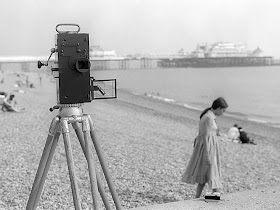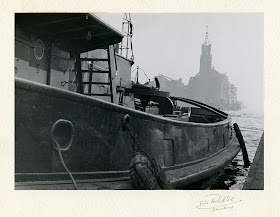This date has a special
significance. It was 100 years ago that
my father was born. He was a
Meisterfotograf (Master Photographer), and it was through his influence and
teaching that I set out on a career as a professional photographer myself. To this day I am still influenced by what I
learned from him. Even this blog most
likely would not have materialized without him.
Heinrich Richter
Photograph by daughter Marlies Amling
Thus I hope the readers of this blog
will allow me this moment of personal reflections.
My father always encouraged me to
take pictures, to experiment, to find my own way. For that reason he gave me my first camera, a
Leica III with 50mm f/2 Summar lens on my 5th birthday. This used to be his personal camera and some of the photographs in this article were taken with that camera.
He attended the Hamburg School of
Photography. After graduating he worked
as an apprentice with several different photographers and finally earned his
degree of Fotografenmeiser (master photographer).
St. Pauli Landungsbrücken Subway Station
Hamburg Harbor
Throughout his career, he never
specialized, instead his work ranged from portraits and weddings, via
architectural work to product photography.
That is something I am quite thankful for because it allowed me to do
the same in my own life.
Unfortunately, cancer took him from
us much too early. I frequently reflect
on the fact that I am right now at the same age as he was when he died, and on
all the conversations we could have had, had he only lived longer.
My sister followed his footsteps
also. She is now a very successful
photographer in Weilburg, Germany. We
often talk about what could have been. For
instance, our dad was an incredibly skillful retoucher. It still amazes me what he was able to do
with a brush and some retouching colors.
We will never know what he would have thought of Photoshop, but we are
convinced he would have taken to it quite readily. As a matter of fact, I am sure he would have
readily embraced digital photography as well, but I am also convinced that he
would have missed the skills that used to be necessary to be a successful
professional photographer before the digital age.



I have several of his cameras in my
own camera collection. Just the other
day I marveled once again at his Plaubel Peco Universal view camera and it occurred
to me that the majority of photographers today probably have no clue how to
operate such a piece of equipment.
Digital photography, combined with computers and software programs like
Photoshop have virtually eliminated the need for such camera equipment. Yet I am very thankful that I still learned
to use cameras like it, as well as most of the other, “old” skills that were
necessary to succeed in the field of professional photography. For that I am forever thankful, dad.
-----------------------------------------------------------------------------------------------------------------------------------------------------------------------------------------------------------------
Please make payment via
PayPal to GMP Photography
Please make payment via
PayPal to GMP Photography
Click on ad to enlarge
Please make payment via
PayPal to GMP Photography
Click on ad to enlarge














































